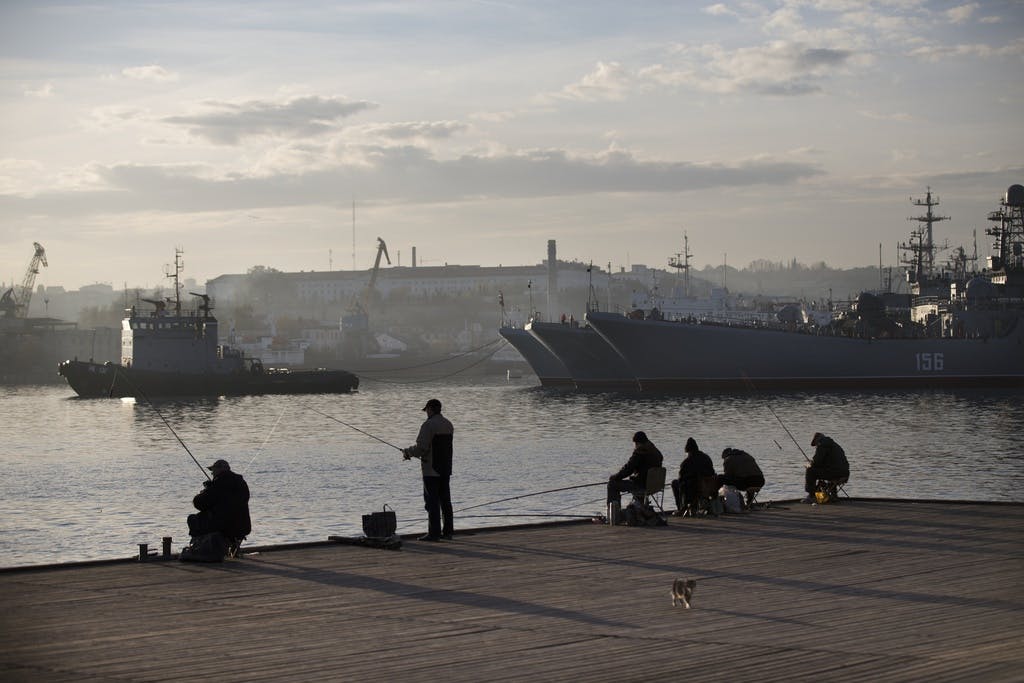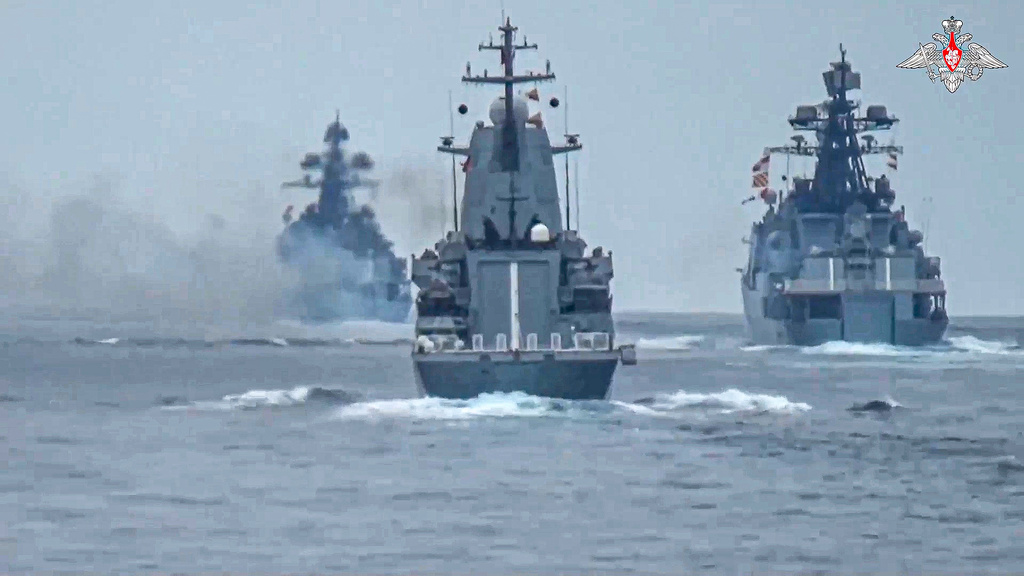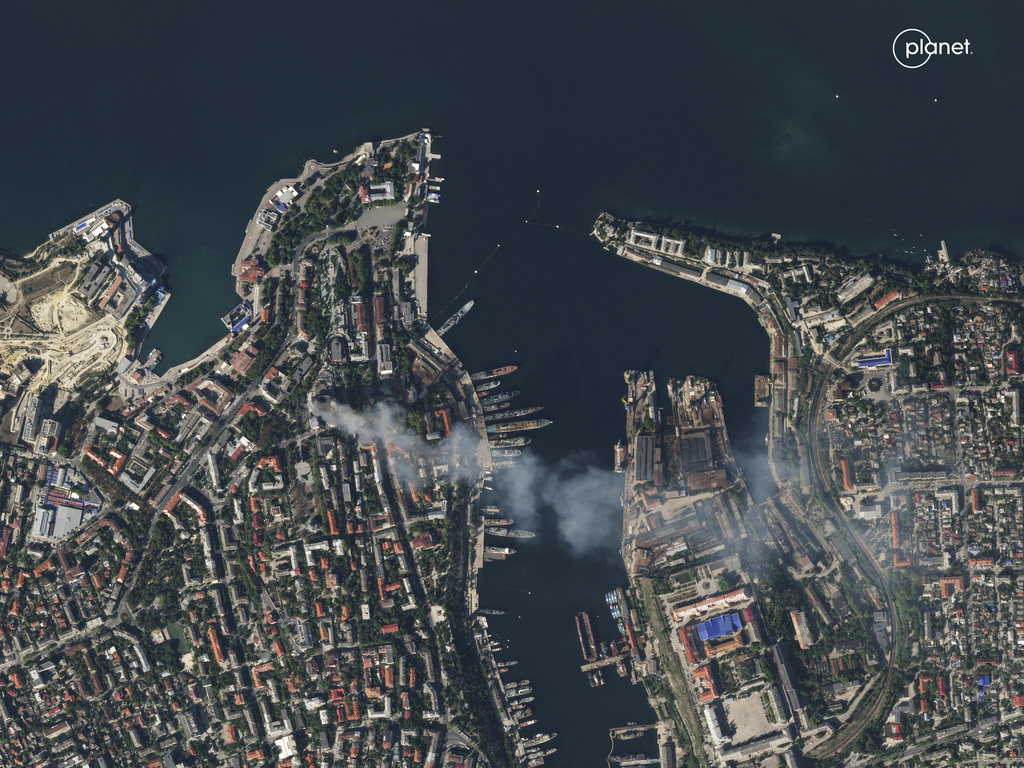Ukraine Knocks Out Moscow’s Black Sea Landing Ships, Leaving Russian Navy ‘Inactive’ There for First Time Since 1783
Given the regional chess game, Russia has little hope of making a naval comeback.

With precise strikes by cruise missiles and sea drones, Ukraine last weekend knocked out the Russian Navy’s last three landing ships operating in the Black Sea. This effectively lifts thcoe threat of beach landings on Ukraine’s coast for the duration of the Russia-Ukraine war. At the same time, Ukraine has pushed Russia’s Navy out of the Western Black Sea. With export sea lanes now open, Washington recently raised its estimate of Ukraine’s grain exports to the world by 34 percent.
Given the regional chess game, Russia has little hope of making a naval comeback. Just prior to its 2022 invasion of Ukraine, Russia moved six landing ships into the Black Sea for “exercises.” After the war started, Turkey cited the 1938 Montreux Convention and blocked new warships from entering the Black Sea. They would have to pass through the sole entrance, the Turkish-controlled Bosphorus Strait.
By sinking or severely damaging $2 billion worth of naval equipment in one weekend, Ukraine is on track to sink half of Russia’s warships in the Black Sea by the end of this year, forecasts the Hudson Institute. Just as the admission of Finland and Sweden turns the Baltic Sea into a NATO sea, this damage to Russia’s Black Sea Fleet undermines future Russian force projection in years ahead in the Mediterranean and the Middle East. In recent years, Black Sea ships aided Russia’s invasion of Georgia in 2008, its annexation of Crimea in 2014 and its intervention in Syria in 2015.
Now, Russia’s Black Sea fleet is “functionally inactive,” Britain’s Defense Minister Grant Shapps tweeted Sunday. “Russia has sailed the Black Sea since 1783, but is now forced to constrain its fleet to port,” he posted on X. “And even there, Putin’s ships are sinking,” he exclaimed.

Watched by naval planners the world over, Ukraine’s Navy, a force without ships, is humbling Russia’s, the world’s third largest after America and China. In a lesson in asymmetrical warfare applicable to defending the Taiwan Strait, Ukraine is using $250,000 home-made sea drones to sink $250 million warships. These kamikaze motorboats run on batteries and are guided by pilots hundreds of miles away.
Overshadowed by world media attention distracted by Mr. Putin’s reelection campaign and the Moscow theater massacre, Russia’s president is quietly trying to shake up his Navy. Last month, he fired the Black Sea Fleet commander, Viktor Sokolov. Last week, he fired the Russian Navy’s Commander in Chief, Nikolai Yevmenov, a five year veteran in the post. Both men are subjects of arrest warrants issued by the International Criminal Court in The Hague on charges of crimes against humanity for directing missile strikes against Ukraine’s power plants during the winter of 2022-2023.
Desperate to stem naval losses, Russia’s defense minister, Sergei Shoigu, 10 days ago visited Sevastopol, home to Russia’s Navy since the days of Catherine the Great. He ordered that all warships be protected around the clock by sentries manning heavy caliber machine guns. To stop underwater drones, steel nets and barges now block entrances to harbors. To confuse Ukrainian drone operators, piers were painted with black silhouettes of decoy submarines. One submarine’s conning tower was protected with a “cope cage,” a metal screen designed to deflect airborne drones.
Ukraine also will adapt, vows Ukraine’s security service chief Vasyl Maliuk. “We never repeat our actions, and if they [Russia] change their defense against our maritime drones somewhere, we are one step ahead,” the head of the SBU security service told Ukraine’s ICTV. “Let the Russians wait for the next explosion.”
Last weekend’s attack was by sea and by air. The Kremlin-installed governor of Sevastopol, Mikhail Razvozhayev, described it on Telegram as the “most massive attack in recent times.” Russian media said anti-aircraft were able to down 11 of 18 incoming Ukrainian rockets.

Using Ukrainian-made sea drones and cruise missiles supplied by France and Britain, the Ukrainian Air Force and Navy damaged the two landing ships — the Azov and the Yamal. One rocket punched a hole in the foredeck of the Yamal, causing her to list to starboard. Only by manning water pumps is the crew able to keep her afloat.
Two rockets reportedly severely damaged the Ivan Khurs, one of only two Russian reconnaissance vessels in the Black Sea. A Ukrainian-made Neptune cruise missile reportedly hit the Konstantin Olshansky, a large landing ship. All three landing ships are of the late-Soviet “Ropucha” or “Toad” class.
Equipped with bow and stern doors for rapid roll-on, roll-off operations, these ships can carry 12 armored personnel carriers and 340 soldiers. Russia started the war with 13 large landing ships in the Black Sea. After last weekend’s attacks, all are damaged or destroyed.
On land in Crimea, last weekend’s cruise missiles made three major strikes. An oil tank farm was set ablaze near Simferopol. A regional communications center for the Navy was bombed at Sevastopol. And cruise missiles hit the military airfield at Belbek, damaging three Su-27 fighter jets and killing around 30 Russian soldiers. Last weekend, only one civilian was reported dead. The cruise missiles’ precision contrasts with the indiscriminate shelling that Sevastopol endured during World War II.
“Ukrainian strikes against [Black Sea Fleet] ships and infrastructure will likely continue to deter Russian forces from redeploying ships to Sevastopol and the western Black Sea,” the Washington-based Institute for the Study of War wrote Monday. It noted that many Russian Navy ships have withdrawn to the relative safety of the port of Novorossiysk, on Russia’s Black Sea coast.
The sea drones have other impacts on Russia’s war effort. Sevastopol, long the unchallenged headquarters of the Black Sea Fleet, has the only infrastructure to load war ships with Russia’s deadly Kalibr cruise missiles. Deprived of access to Sevastopol, Russia’s missile frigates are firing fewer Kalibr cruise missiles at southern Ukraine, the Ukrainian Southern Command spokeswoman, Colonel Nataliya Humenyuk, tells reporters.
Because of repeated attacks on the 12-mile bridge linking Crimea with the Russian mainland, the number of trains making the crossing has dwindled to four or five passenger and general cargo trains a day, Mr. Maliuk, the security chief, told Interfax-Ukraine Monday. He said that before the attacks up to 46 trains carrying weapons and ammunition crossed the bridge daily. A pet project of Mr. Putin, the six-year-old bridge cost almost $4 billion. Last November, the Ukrainian security chief predicted: “That bridge is doomed.”

